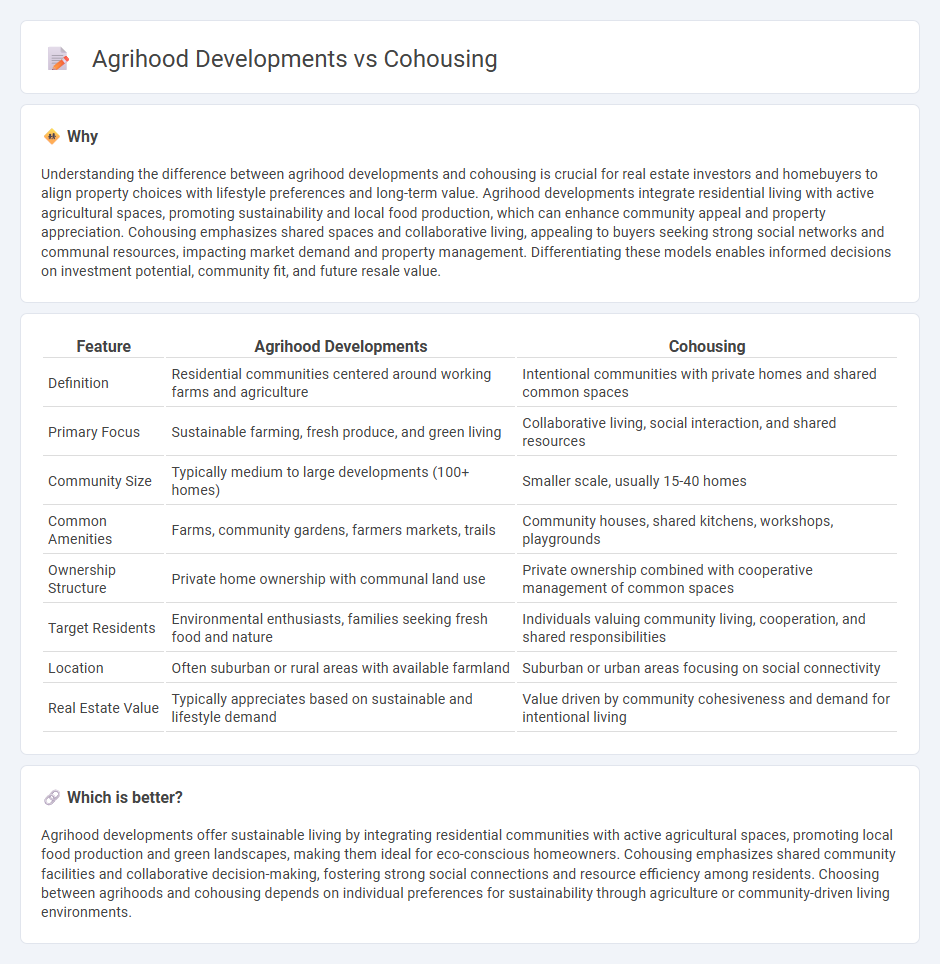
Agrihood developments integrate sustainable agriculture with residential living, emphasizing community gardens, farm-to-table amenities, and green spaces that promote environmental stewardship. Cohousing communities focus on shared living spaces, collaborative decision-making, and social interaction through common houses and group activities, fostering a strong sense of neighborhood cooperation. Explore the distinct benefits and evolving trends of agrihoods and cohousing to determine the best fit for your lifestyle.
Why it is important
Understanding the difference between agrihood developments and cohousing is crucial for real estate investors and homebuyers to align property choices with lifestyle preferences and long-term value. Agrihood developments integrate residential living with active agricultural spaces, promoting sustainability and local food production, which can enhance community appeal and property appreciation. Cohousing emphasizes shared spaces and collaborative living, appealing to buyers seeking strong social networks and communal resources, impacting market demand and property management. Differentiating these models enables informed decisions on investment potential, community fit, and future resale value.
Comparison Table
| Feature | Agrihood Developments | Cohousing |
|---|---|---|
| Definition | Residential communities centered around working farms and agriculture | Intentional communities with private homes and shared common spaces |
| Primary Focus | Sustainable farming, fresh produce, and green living | Collaborative living, social interaction, and shared resources |
| Community Size | Typically medium to large developments (100+ homes) | Smaller scale, usually 15-40 homes |
| Common Amenities | Farms, community gardens, farmers markets, trails | Community houses, shared kitchens, workshops, playgrounds |
| Ownership Structure | Private home ownership with communal land use | Private ownership combined with cooperative management of common spaces |
| Target Residents | Environmental enthusiasts, families seeking fresh food and nature | Individuals valuing community living, cooperation, and shared responsibilities |
| Location | Often suburban or rural areas with available farmland | Suburban or urban areas focusing on social connectivity |
| Real Estate Value | Typically appreciates based on sustainable and lifestyle demand | Value driven by community cohesiveness and demand for intentional living |
Which is better?
Agrihood developments offer sustainable living by integrating residential communities with active agricultural spaces, promoting local food production and green landscapes, making them ideal for eco-conscious homeowners. Cohousing emphasizes shared community facilities and collaborative decision-making, fostering strong social connections and resource efficiency among residents. Choosing between agrihoods and cohousing depends on individual preferences for sustainability through agriculture or community-driven living environments.
Connection
Agrihood developments integrate community-centered farming with residential living, fostering sustainable lifestyles and shared resources among residents. Cohousing emphasizes collaborative design and social interaction, promoting communal spaces and collective decision-making within neighborhoods. Both models prioritize enhancing social cohesion, environmental stewardship, and resident engagement through intentional, community-driven real estate development.
Key Terms
Shared Amenities
Cohousing developments prioritize shared amenities such as communal kitchens, multipurpose rooms, and gardens designed to foster social interaction and cooperative living among residents. Agrihoods emphasize agricultural features, including community farms, orchards, and farmers' markets that promote sustainable living and local food production. Explore the distinctive benefits of each model to determine the best fit for your lifestyle and community goals.
Community Governance
Cohousing developments emphasize shared decision-making through resident-led councils and consensus-based governance structures, fostering strong community bonds and equitable participation. Agrihoods integrate agricultural management with neighborhood planning, often involving partnerships between residents and professional farmers to oversee land use and sustainability practices. Explore how these governance models shape social dynamics and community resilience in planned living environments.
Sustainable Land Use
Cohousing communities emphasize shared living spaces and collaborative resource management, promoting sustainable land use by reducing individual housing footprints and preserving green areas. Agrihood developments integrate agricultural land into residential neighborhoods, fostering local food production and enhancing biodiversity through sustainable farming practices. Explore how these innovative housing models contribute to eco-friendly living and land conservation.
Source and External Links
Cohousing - Cohousing is an intentional, self-governing cooperative community where residents live in private homes clustered around shared spaces like common houses and gardens, promoting social interaction and collaborative management while maintaining private lives.
THE COHOUSING COMPANY - Cohousing communities feature private homes arranged around shared common areas, with collective decision-making, no hierarchy, self-management, and a balance between social engagement and individual privacy.
Beyond Contact-Intergenerational Living in Cohousing - Cohousing combines private homes with shared facilities like gardens and common houses, encouraging intergenerational mingling, community management, and varied architectural forms tailored to different settings.
 dowidth.com
dowidth.com